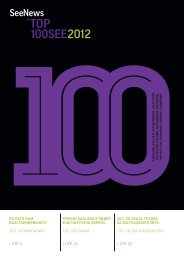корица 1 парциален лак - SEE Top 100 - SeeNews
корица 1 парциален лак - SEE Top 100 - SeeNews
корица 1 парциален лак - SEE Top 100 - SeeNews
Create successful ePaper yourself
Turn your PDF publications into a flip-book with our unique Google optimized e-Paper software.
www.top<strong>100</strong>.seenews.com<br />
33.2%<br />
Dependence of <strong>SEE</strong> Countries оn Russian Gas (%)<br />
50%<br />
Slovenia<br />
Croatia<br />
<strong>100</strong>%<br />
99%<br />
Bosnia and<br />
Herzegovina<br />
Serbia<br />
Montenegro<br />
Kosovo<br />
Albania<br />
Macedonia<br />
region en route to the heart of Europe - in case<br />
there is a supply contract and a functioning<br />
pipeline. In fact, Bulgaria suggested in July<br />
2010 that it could develop an interconnection<br />
pipeline with Turkey that would become the<br />
first operating section in the future Nabucco<br />
pipeline.<br />
Another way of boosting security in times<br />
of disruptions and achieving a degree of<br />
independence from gas imports is the<br />
construction of gas storages. There are eleven<br />
active UGS across Southeastern Europe and<br />
there are projects for new storage facilities<br />
to be built in Albania, Bulgaria, Croatia<br />
and Serbia.<br />
15%<br />
<strong>100</strong>%<br />
Romania<br />
Bulgaria<br />
<strong>100</strong>%<br />
Moldova<br />
Gas Storages in <strong>SEE</strong><br />
Country Gas Storage Operator<br />
Storage Capacity<br />
(billion cu m)<br />
Albania*<br />
Divjaka<br />
Dumre<br />
-<br />
-<br />
0,06<br />
0.65-1.20<br />
Bulgaria Chiren Bulgartransgaz EAD 0.45<br />
Croatia Okoli Plinarco d.o.o. 0.63<br />
Bilciuresti<br />
Romgaz SA<br />
1.55<br />
Sarmasel<br />
Romgaz SA<br />
1.02<br />
Targu Mures<br />
Depomures SA<br />
0.35<br />
Romania<br />
Urziceni<br />
Romgaz SA<br />
0.27<br />
Gherceati<br />
Romgaz SA<br />
0.43<br />
Cetatea de Balta<br />
Romgaz SA<br />
0.25<br />
Nades-Prod-Seleus<br />
Amgaz SA<br />
0.08<br />
Balaceanca<br />
Romgaz SA<br />
0.05<br />
Serbia Banatski Dvor - Phase I JP Srbijagas 0.30<br />
99%<br />
* Projects for UGS, feasibility study completed Sources: Storage Operators; National Energy Regulators; The Energy Community<br />
Regasification terminals could also bring<br />
diversification of gas supplies, yet the need<br />
for such facilities in <strong>SEE</strong> is strongly debatable.<br />
Croatia has been expecting its LNG (liquefied<br />
natural gas) terminal on the Island of Krk<br />
for quite a while. In June 2010 investors in<br />
the project, among which Austria’s OMV<br />
AG and Germany’s E.ON Ruhrgas, once<br />
again postponed their final decision for<br />
the construction of the terminal due to<br />
oversupply on the European gas market. The<br />
terminal is not expected to come on stream<br />
before 2017, according to OMV officials.<br />
Albania has also invited foreign investors<br />
Data for 2008 and 2009 where available<br />
Sources: <strong>SeeNews</strong>; The Energy Community; National Energy Regulators<br />
interested in the construction of LNG<br />
terminals on its Adriatic coast near Fier but<br />
the future of those projects is yet unclear.<br />
LOCAL INCENTIVES IN THE<br />
GAS SECTOR<br />
The national gas systems in Southeastern<br />
Europe are at different stages of development.<br />
While Romania, Bulgaria, Serbia, Croatia<br />
and Slovenia have more or less mature gas<br />
markets, their neighbours are still studying<br />
the possibilities to build their own gas<br />
networks.<br />
Throughout the region, all the countries<br />
have drawn up expansion plans for their<br />
gas networks. Even Albania and Kosovo<br />
are sketching the routes of their future grid<br />
connections. A 120-km link between the gas<br />
transportation systems of Bosnia and Croatia<br />
is projected to be built in the near future;<br />
Macedonia is also preparing projects for<br />
extending its transmission pipelines further<br />
west to its border with Albania, to Kosovo<br />
in the north and to Greece in the south.<br />
Beside the projects of national importance,<br />
there are projects of a larger scale, connecting<br />
three or more markets in the region – the<br />
Ionian-Adriatic Pipeline (IAP) and the<br />
Energy Community Gas Ring (or the gas<br />
<strong>SEE</strong> TOP Industry Profiles<br />
ring of the Western Balkans).<br />
IAP will be a 400 km high-pressure pipeline<br />
that would link Albania and Croatia via<br />
Montenegro. The pipeline will carry 5.0<br />
billion cu m of natural gas portioned out<br />
between Albania, Montenegro, Bosnia<br />
and Croatia. The aim of the project is to<br />
establish domestic gas markets in Albania<br />
and Montenegro and to set the stage for the<br />
implementation of the Energy Community<br />
Gas Ring.<br />
The gas ring in the Western Balkans is a<br />
preliminary concept for linking the markets<br />
of Albania, Bosnia, Croatia, Kosovo,<br />
Macedonia, Montenegro and Serbia.<br />
According to estimations of the <strong>SEE</strong> Regional<br />
Gasification Study, the total length of the ring<br />
will be nearly 1,300 km and the calculated<br />
costs for installing the pipelines only will top<br />
USD 775 mln. The project has a couple of<br />
options in terms of supply – via the existing<br />
routes carrying gas from Russia; through<br />
the Greek transmission system; from the<br />
proposed Nabucco pipeline, or the Blue<br />
Line. Yet, either of these alternatives would<br />
require additional offtakes to pump gas from<br />
the main transmission pipeline into the ring,<br />
which will incur additional capital spending.<br />
Resting on too many conditions and<br />
promising little chances of success, the gas<br />
ring in <strong>SEE</strong> remains a remote concept for<br />
the development of a regional gas system.<br />
<strong>SEE</strong> AT THE CENTRE OF TWO<br />
MAJOR PROJECTS<br />
The <strong>SEE</strong> countries hope that the future major<br />
pipelines like Nabucco and South Stream,<br />
which would cross the region carrying<br />
Russian, Caspian and Middle East gas to<br />
central and western Europe, would boost<br />
the development of their own gas networks.<br />
The Nabucco pipeline will cross the territories<br />
of Bulgaria and Romania and provide them<br />
with connections to Turkey and Hungary,<br />
respectively. The South Stream pipeline will<br />
probably split into two arms: a southwestern<br />
one that will go via Bulgaria and Macedonia<br />
to Greece and further west to Italy; and a<br />
northwestern one heading from Bulgaria to<br />
Romania, Serbia and Slovenia, before ending<br />
at the Baumgarten gas hub in Austria.<br />
If these projects win enough investor support<br />
and political approval across the region,<br />
the countries along their routes will benefit<br />
from the new gas infrastructure within their<br />
territories and the potential volumes of gas<br />
deliveries for the local economies.<br />
Ultimately, the construction of a number<br />
of smaller spur lines to either Nabucco<br />
or South Stream could bring natural gas<br />
to neighbouring gas systems left astray<br />
and speed up the connection between the<br />
individual gas systems in the region.<br />
<strong>SEE</strong> TOP Industry Profiles<br />
37<br />
page 37





